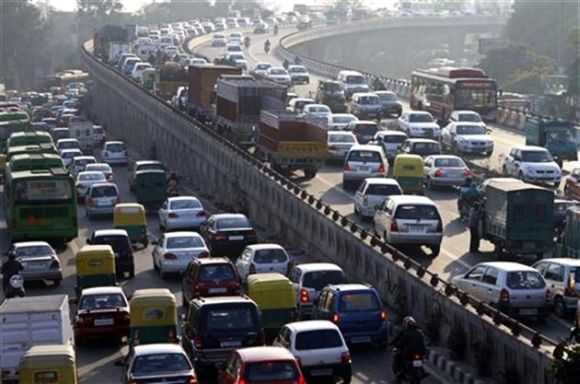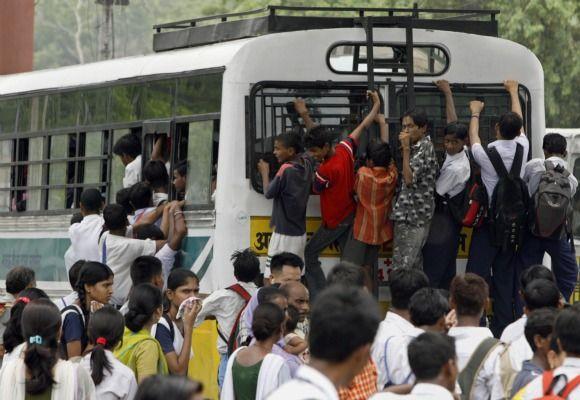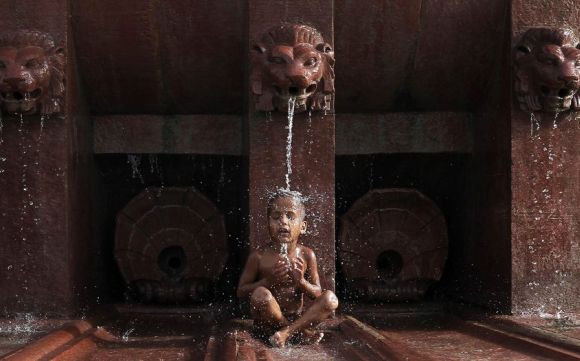Photographs: Vijay Mathur/Reuters A K Bhattacharya in New Delhi
Once you analyse the data, you will realise the state government wants to take credit for achievements that do not belong to it.
The government of Sheila Dikshit in Delhi has launched a high-profile campaign to highlight the achievements of her regime in the last fifteen years.
Most governments undertake such an exercise before going to elections. Delhi assembly elections are due to be held later this year. Therefore, this is no surprise. What, however, comes as a surprise is the way the Delhi government has used data to project its performance.
While several achievements mentioned in the various publicity documents are backed by numbers, there are also many claims where the data reveal a lot more than what the government has chosen to highlight.
Taking a look at them would give you an indication of the direction Delhi's growth path has taken in the last 15 years.
Delhi's per capita income, the billboards in several parts of the city claim, has gone up five times in the last five years.
...
Should you trust Delhi govt's claims on the city's growth?
Image: India Gate in New Delhi.Photographs: Adnan Abidi/Reuters
Against about Rs 40,000 in 1998, the per capita income of a Delhi resident today is Rs 200,000.
Compare that with the national per capita income increase in roughly the same period, you would realise how Delhi has done slightly better than India.
The per capita income for the whole country in this period has gone up by four and a half times at around Rs 69,000.
Is Delhi's achievement in raising the income level of its residents that laudable? There would be arguments on both sides.
There are those who would point out that on a relatively high income base, Delhi has done well to keep growing at that rate.
But there are also those who would point out that the capital city should have seen much higher growth because its economy is dependent to a great extent on the services sector that grew at a much more rapid pace than either industry or agriculture in this period.
...
Should you trust Delhi govt's claims on the city's growth?
Image: Traffic moves along a busy road in New Delhi.Photographs: B Mathur/Reuters
Either way, there is little doubt that the Delhi government's campaign would have been far more effective, and transparent, if while claiming a five times increase in the per capita income of its residents in the last fifteen years, it had also given a comparison with the rise in the country's per capita income in the same period.
Then there is the jaw-dropping claim that in the last one decade the city of Delhi saw the addition of 66 fly-overs to improve road connectivity and smoother traffic movement.
Urban city-planners may not be very thrilled over this claim. They would argue that a larger number of fly-overs benefits private vehicle movement more than public transport.
But such critics would perhaps be silenced by the Delhi government's subsequent claim that in the last decade or so, the coverage of Delhi Metro has also increased from a distance of around 7 kilometres to 186 kilometres.
Consequently, the daily number of passengers carried by Delhi's mass rapid transport network has gone up from just around 100,000 to 2.2 million today.
...
Should you trust Delhi govt's claims on the city's growth?
Image: School children travel on an over-crowded bus in New Delhi.Photographs: Adnan Abidi/Reuters
Add the 4.5 million of passengers carried daily by the 5,900 buses operated by the Delhi Transport Corporation (DTC), you would get a sense of the growing footprint of public transport in the country's capital city.
A decade ago, DTC with its 3,100 buses would carry only 2.5 million passengers a day.
A quick calculation would also tell you that in the last ten years the number of passengers each DTC bus carries per day has, therefore, declined in this period.
What about the availability of potable water in Delhi? The government's claims show that it now produces and supplies 853 million gallons of water per day, compared to only 544 million gallons in 1998.
That is a major improvement, if taken together with the increase in the length of the water pipelines from 9,000 kilometres to 16,000 kilometres in this period. But these do not reveal the actual ground reality, which is not that rosy.
...
Should you trust Delhi govt's claims on the city's growth?
Image: A boy cools himself off as he sits under a fountain on a hot summer day in New Delhi.Photographs: Adnan Abidi/Reuters
Rampant water theft and leakages, made easier through lax enforcement of metered supplies, have prevented the city administration from ensuring uninterrupted water availability.
The bigger problem with Delhi's growth in the last fifteen years is not with its income level or public transportation, but with its healthcare sector.
Even here the weaknesses surface only after a closer reading of the data that the Delhi government has put out in its campaign.
It claims that Delhi's hospitals now have 43,500 beds, showing a significant jump from 24,000 beds in 1998.
Indeed, this shows that the ratio of population per bed has declined from 577 to 385 in this period. This is nowhere near what it ought to be, but certainly a marked improvement.
...
Should you trust Delhi govt's claims on the city's growth?
Photographs: Lee Celano/Reuters
However, what the data do not tell you is the composition of these hospital beds that have been added in the last decade and a half.
Almost 40 per cent of these beds today are provided by private-sector hospitals. Another 24 per cent of the beds are accounted for by hospitals run by the Union government.
Only the remaining 36 per cent of the beds have come from hospitals run by the Delhi government or by the municipal corporations.
Driving growth in the healthcare sector with the involvement of the private sector has its own consequences and those at the helm of the Delhi government need to be aware of the necessary policy imperatives to correct the distortions such a growth path entails.








article